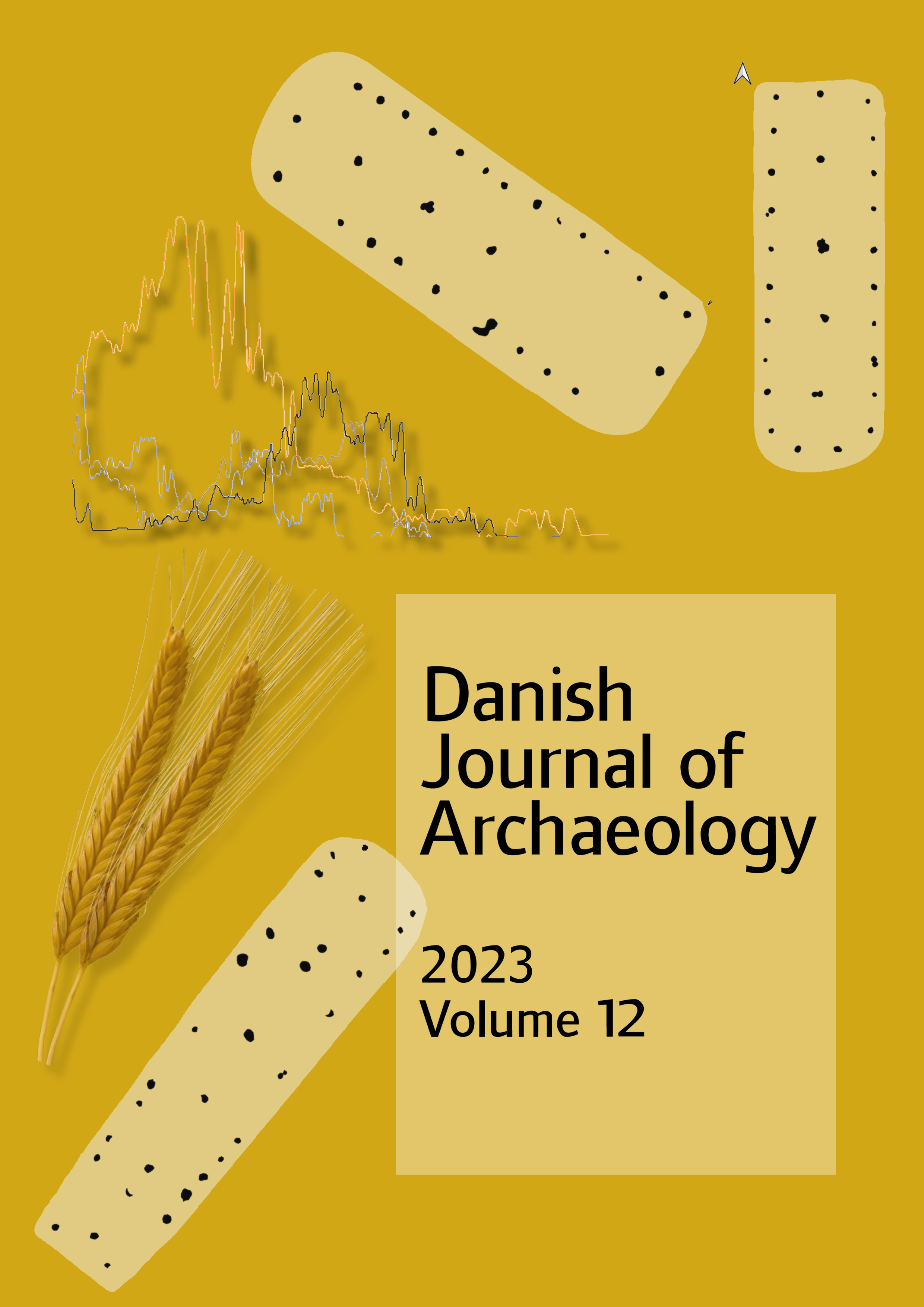Maglehøj – preservation of birch bark in a passage grave with evidence of forced entry in prehistory
DOI:
https://doi.org/10.7146/dja.v12i1.135026Keywords:
Neolithic, Maglehøj, passage grave, birch bark, secondary intrusion, climate monitoringAbstract
Maglehøj is a Danish passage grave which has birch bark incorporated into its construction. An account of the opening of the monument in 1823 reports the discovery of an earth-free chamber and describes constructional details, including the use of birch bark. An investigation undertaken in 1997, prompted by the information given in this account, revealed that the birch bark was relatively well preserved and that there had been a break-in through one gable of the chamber later in prehistory. This article gives several examples of similar intrusions, which were a more common phenomenon than previously appreciated. The results of a 12-month investigation of the climatic conditions inside Maglehøj’s chamber, aimed at optimising preservation of the birch bark, are also presented. The investigation included measurements of air change and humidity carried out under different conditions. The outcome was a recommendation that the entrance to the chamber be closed with an air-tight seal.
References
Boye, V., 1862. Udgravning af en Jættestue ved Hammer. Et Bidrag til Opfattelsen af de i Steenalderen herskende Gravskikke. Annaler for nordisk Oldkyndighed og Historie 1862, 323-355.
Cummings, V. and Richards, C., 2021. Monuments in the Making. Raising the great dolmens in early Neolithic northern Europe. Exeter: Oxbow Books.
Dehn, T., Hansen, S. I. and Kaul, F., 2000. Klekkendehøj og Jordehøj. Restaureringer og undersøgelser 1985-1990. Stenaldergrave i Danmark vol. 2. København: Skov- og Naturstyrelsen.
Dehn, T. and Hansen, S. I., 2006. Birch bark in Danish passage graves. Journal of Danish Archaeology 14, 23-44. https://doi.org/10.1080/0108464x.2006.10590109
Ebbesen, K., 2011. Danmarks megalitgrave. Bind 1,1. Forfatterforlaget. København: Attika.
Eriksen, P., Dehn, T. and Hansen, S.I., in press. Chapter 4A. Architecture and excavation. In: P. Kjærum, P. Eriksen, A.B. Gebauer and T. Madsen, eds. Megaliths and Rituals at Tustrup, Denmark. Odder: Moesgaard.
Hansen, S. I., 2014. Bornholms jættestuer. In: P.O. Nielsen, F.O.S. Nielsen and C. Adamsen, eds. Solstensøen. På sporet af Bornholms bondestenalder. Rønne: Bornholms Museum, 47-80.
Hansen, S. I., 2016. Jættestuebyggerne. Arkitektur i Danmarks stenalder. Them: Kahrius.
Iversen, R., Thorsen, M. S. and Andresen, M. J.-B.R., 2022. Neolithic Cupmarks from Vasagård on Bornholm, Denmark: Dating the Rock Art Tradition in Southern Scandinavia. European Journal of Archaeology 25(2), 155-175. https://doi.org/10.1017/eaa.2021.49
Jakobsen, T. B., 2007. Birth of a World Museum. Acta Archaeologica Supplementa VIII/Acta Archaeologica 78:1, 2007. Oxford: Wiley – Blackwell.
Larsen, P.K., Jensen, L.A., Ryhl-Svendsen, M. and Padfield, T., 2017. The microclimate within a Neolithic passage grave. In: J. Bridgland, ed.. ICOM-CC 18th Triennial Conference Preprints, Copenhagen, 4–8 September 2017. Paris: International Council of Museums, 1-9.
Orsini, S., Ribechini, E., Modugno, F., Klügl, J., Di Pietro, G. and Colombini, M.P., 2015. Micromorphological and chemical elucidation of the degradation mechanisms of birch bark archaeological artefacts. Heritage Science, vol 3(2), 1-11. https://doi.org/10.1186/s40494-015-0032-7
Paulsson, B. S., 2010. Scandinavian Models: Radiocarbon dates and the origin and spreading of passage graves in Sweden and Denmark. Radiocarbon, vol. 52(3), 1002-1017. https://doi.org/10.1017/S0033822200046099
Rosenberg, G., 1929. Nye Jættestuefund. Aarbøger for Nordisk Oldkyndighed og Historie 1929, 189-262.
Thomsen, C. J. and Thorlacius, B., 1827. Fortegnelse paa de Oldsager, som fra 1 Nov. 1820 til 1 Juli 1823 ved Gave eller Kjøb ere komne til Museet. Antiquariske Annaler IV, 159-266.
Thorvildsen, K., 1946. Grønhøj ved Horsens. En jættestue med offerplads. Aarbøger for Nordisk Oldkyndighed og Historie 1946, 73-94.
Downloads
Published
How to Cite
Issue
Section
License
Copyright (c) 2023 Torben Dehn, Poul Klenz Larsen

This work is licensed under a Creative Commons Attribution-NonCommercial-ShareAlike 4.0 International License.
Counting from volume 11 (2022), articles published in DJA are licensed under Attribution-NonCommercial-ShareAlike 4.0 International (CC BY-NC-SA 4.0). The editorial board may accept other Creative Commons licenses for individual articles, if required by funding bodies e.g. the European Research Council. With the publication of volume 11, authors retain copyright to their articles and give DJA the right to the first publication. The authors retain copyright to earlier versions of the articles, such as the submitted and the accepted manuscript.
Articles in volume 1-8 are not licensed under Creative Commons. In these volumes, all rights are reserved to DJA. This implies that readers can download, read, and link to the articles, but they cannot republish the articles. Authors can upload their articles in an institutional repository as a part of a green open access policy.
Articles in volume 9-10 are not licensed under Creative Commons. In these volumes, all rights are reserved to the authors of the articles respectively. This implies that readers can download, read, and link to the articles, but they cannot republish the articles. Authors can upload their articles in an institutional repository.





